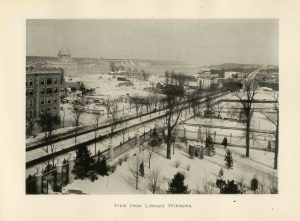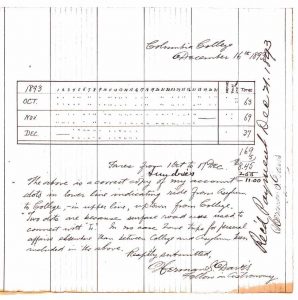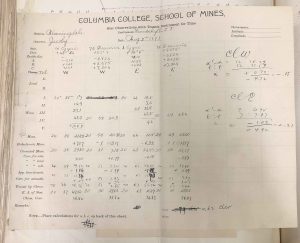Throughout the year, we have celebrated Columbia’s 125 years in Morningside Heights, since classes started on the new campus in October 1897. But Columbia actually has a slightly longer history on this site: Columbia built its very first structure on the new grounds in 1892 while the Bloomingdale Asylum was still operational. Welcome to the Bloomingdale Observatory.

Columbia signed an agreement with New York Hospital for the site of the Bloomingdale Asylum in March 1892. Just a few months later, in June 1892, Astronomy Professor John K. Rees received funds (not to exceed $750) to build an observatory on the new site to determine variations of latitude. [1] By November 1892, a small observatory, about 15 feet in diameter, was erected on the new site, with the consent of the Society of the New York Hospital, near the southwest corner of Amsterdam Avenue and West 118th Street. This was the first Columbia building in Morningside Heights.
So how did the astronomers and the Asylum work together? When observations started in April 1893, Rees would actually stay at the Bloomingdale Asylum. (Yes, the still operating facility with patients.) The Medical Superintendent Samuel Lyon sent keys to Rees for the “nearest front room in the Patients Hall opening from the first floor center to the east.” And Lyon noted “only quiet and comfortable gentlemen occupy the hall.” Later on, astronomy instructor Herman S. Davis was also occasionally allowed to stay at the Asylum, but Lyons suggested that “it would be wiser to have him take his meals elsewhere.” (Keeping in mind that there weren’t many dining options in this part of the city at the time.) When graduate students reported to work at the observatory, they would have to present Prof. Rees’s card to the Asylum’s Gatekeeper who would then allow them to enter the property.

Staying on site was not always an option and the daily commute was somewhat trickier. During the academic year, from October 1893 to March 1894, Davis routinely traveled from the 49th Street Columbia campus, where he taught classes, to the new site on 116th Street, to make observations between midnight and morning. From Davis’ transportation reimbursement requests, we learn that the car fare was 5 cents per trip. The following year, the Asylum vacated the site and moved to White Plains. Just as the crew team who was allowed to room at Macy Villa (now Buell Hall) for their spring training, Davis was given permission to stay on the second floor of the Villa (and so avoiding the commute), while campus architect Charles McKim occupied the first floor, from June to November 1895.
But construction on the new site eventually meant that Davis not only had to vacate his uptown flat (the water had to be turned off), but that the observatory itself would also have to be removed for the construction of Schermerhorn and Physics (now Fayerweather) Halls. The observatory was moved at the beginning of 1896 and was relocated to the southeast corner on Broadway and West 120th Street. Using this small observatory, Columbia’s very first structure on the new site, the astronomers continued their latitude observations until these were completed in 1900. A Bloomingdale Station or 116th Street observation log from 1893-1894 is part of the Department Astronomy records.

So for those of you keeping score at home, this means that this year is actually Columbia’s 129th in Morningside Heights.
If you’d like to learn more about Columbia’s move uptown and the first day of classes on the new campus, please enjoy this video of the Curatorial Short “October 1897: Welcome to Morningside Heights,” which was presented in April 2022.
[1] What are variations of latitude? This term is used to refer to “the method of simultaneous observation at corresponding observatories widely separated by longitude, but in nearly the same parallel of latitude.” According to astronomy professor Harold Jacoby, Columbia was the first institution to apply this method “in the right way” in a project in conjunction with the Observatory at Capodimonte in Naples, Italy, under the direction of Emmanuele Fergola.